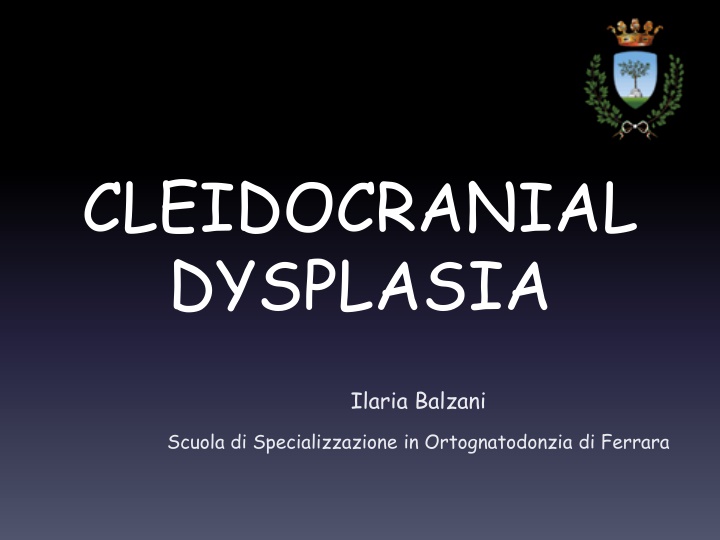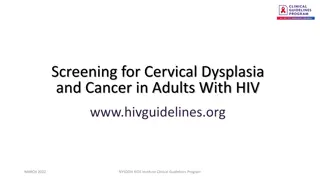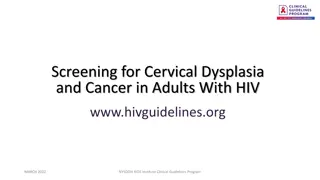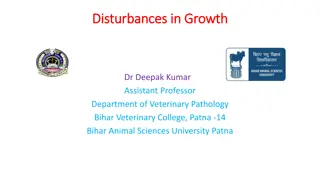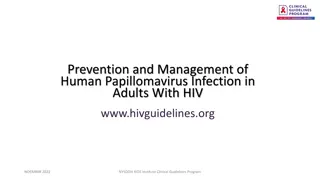CLEIDOCRANIAL DYSPLASIA
Cleidocranial dysplasia (CCD) is an autosomal dominant skeletal dysplasia characterized by delayed closure of cranial sutures, dental abnormalities, and more. The molecular defect in CCD involves the RUNX2 gene, impacting bone formation and tooth development. Clinical manifestations include short stature, delayed fontanelle closure, facial abnormalities, and more. CCD's epidemiology varies globally, with a higher prevalence in specific populations like those in South Africa. This condition showcases a complex interplay between genetics and physical traits.
Download Presentation

Please find below an Image/Link to download the presentation.
The content on the website is provided AS IS for your information and personal use only. It may not be sold, licensed, or shared on other websites without obtaining consent from the author.If you encounter any issues during the download, it is possible that the publisher has removed the file from their server.
You are allowed to download the files provided on this website for personal or commercial use, subject to the condition that they are used lawfully. All files are the property of their respective owners.
The content on the website is provided AS IS for your information and personal use only. It may not be sold, licensed, or shared on other websites without obtaining consent from the author.
E N D
Presentation Transcript
CLEIDOCRANIAL DYSPLASIA Ilaria Balzani Scuola di Specializzazione in Ortognatodonzia di Ferrara
Cleidocranial dysplasia (CCD) [OMIM 119600] is an autosomal dominant skeletal dysplasia characterized by delayed closure of the cranial sutures, hypoplastic or aplastic clavicles, and multiple dental abnormalities.
The molecular defect in CCD is situated at the chromosomal locus of 6p2116. The determinant gene, RUNX2 codes for a core-binding transcription factor protein (CBFA1), which is involved in the differentiation of osteoblasts and bone formation. (Cleidocranial dysplasia: a review of the dental, historical, and practical implications with an overview of the South African experience. Oral Surg Oral Med Oral Pathol Oral Radiol.2013 Jan;115(1):46-55).
RUNX2 plays an important role in the epithelial-mesenchymal interactions that control progressive tooth morphogenesis and histodifferentiation of the epithelial enamel organ.
EPIDEMIOLOGY Whereas the worldwide prevalence of CCD is generally regarded as being about 1 per million, in the mixed ancestry community of Cape Town, South Africa, the minimum prevalence is 100 per million. (Cleidocranial dysplasia: clinical and molecular genetics, Stefan Mundlos, J Med Genet 1999; 36: 177-182)
CLINICAL MANIFESTATION Height: Short stature, moderate. Head: Delayed fontanelle closure Parietal bossing Anterior fontanelle open in adults
Face: Frontal bossing Metopic groove Midface hypoplasia Micrognathia Ears: Deafness
Eyes: Hypertelorism Nose: Low nasal bridge Mouth: Cleft palate Narrow, high-arched palate
Teeth: Delayed eruption of deciduous teeth Delayed eruption of permanent teeth Supernumerary teeth Retention cysts
External Features: Narrow thorax Abnormal facility in opposing the shoulders Ribs, Sternum, Clavicles and Scapulae: Small scapula Hypoplastic clavicles Aplastic clavicles Short ribs Cervical ribs
Skull: Wormian bones Bossing of frontal bone Bossing of occipital bone Bossing of parietal bone Calvarial thickening Absent frontal sinuses Absent paranasal sinuses Hypoplastic frontal sinuses Hypoplastic paranasal sinuses Large foramen magnum
Spine: Spondylolysis Spondylolisthesis Scoliosis Kyphosis Pelvis: Wide pubic symphysis Coxa vara Hypoplastic iliac wing
Hands: Brachydactyly metacarpal phalanges fifth Long second Short second Cone-shaped phalangeal epiphyses middle and of fingers
HYPERDONTIA Hyperdontia is the major dental feature of CCD. This developmental abnormality can involve either, or both the primary and secondary dentition. In CCD, hyperdontia leads to dental impaction, overcrowding, and malocclusion, while midfacial hypoplasia can exacerbate these problems. .
Articulation and mastication may be compromised, and the cosmetic appearance of the dentition may be unsightly. In addition to hyperdontia, other dental abnormalities include delayed eruption and retention of the primary and secondary dentition. The crowns of the teeth sometimes appear abnormal and the enamel may be hypoplastic.
Hyperdontia: pantamogram of an affected male showing multiple supernumerary teeth
DIAGNOSIS Chromosome analysis: on occasion individuals with CCD have cytogenetically visible complex chromosome rearrangements. (Purandare et al. 2008) Gene: to date, RUNX2 (CBFA1) is the only gene in which mutations are known to cause CCD.
Clinical testing: summary of Molecular Genetic Used in Cleidocranial Dysplasia
When the diagnosis of CCD is suspected, the clinician should request a skeletal survey that includes: (1) anteroposterior (AP) and lateral projections of the skull and thorax; (2) AP of the pelvis; (3) lateral of the lumbar spine; and (4) AP of the long bones, hands, and feet.
Sequence analysis, followed by deletion/duplication analysis, can be considered for diagnostic confirmation, particularly if the findings do not meet clinical and radiologic diagnostic criteria. CCD can be diagnosed by ultrasound examination in the offspring of an affected parent as early as 14 weeks gestation.
TREATMENT Dental: the goal of treatment is to improve appearance and to provide a functioning masticatory mechanism. The goals may be achieved with prosthetic replacements, with or without prior extractions; by removal of the supernumerary teeth followed by surgical repositioning of the permanent teeth;
and by a combination of surgical and orthodontic measures for actively erupting and aligning the impacted permanent teeth. (Roberts et al. 2013) Sinus and middle ear infections require aggressive and timely treatment; tympanostomy tubes should be considered when middle ear infections are recurrent (Visosky et al 2003)
Skeletal: if bone density is below normal on DEXA, treatment with calcium and vitamin D supplementation should be considered. Preventive treatment for osteoporosis should be initiated at a young age since peak bone mineral density is achieved in the second and third decade.
Craniofacial: the fontanels close with time in the majority of individuals and cranial remodeling is usually not necessary. Affected individuals may consider having correction of the depressed forehead or lengthening of the hypoplastic clavicles for cosmetic reasons. (Kang et al. 2009, Sewell et al. 2013)
